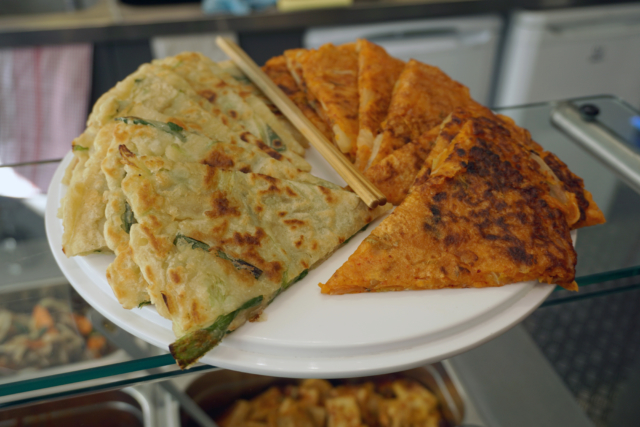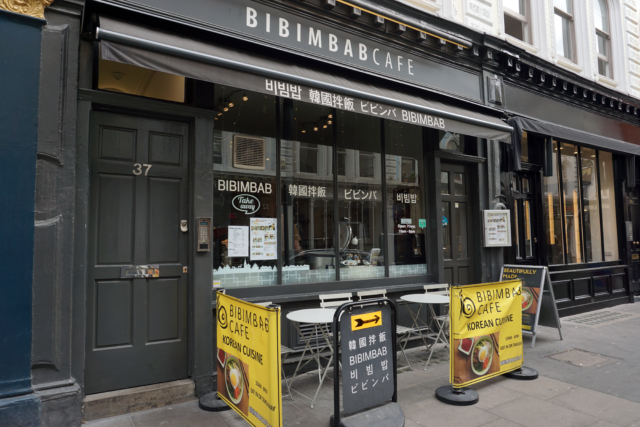#12 in the series – challenges & innovations for Korean restaurants abroad
A conversation with owner and chef Sa Yong Kim at Bibimbab Cafe, London
Any creative process starts with observing. That’s precisely what Sa Yong Kim, chef and owner of Korean restaurant Bibimbab Cafe did. It’s how he drew his own conclusions about the essence of Korean food. And how he made decisions as to how he presents and introduces Korean cuisine to people from all over the world. It’s a heavy load to carry, but Mr. Kim sees it as his duty, and one he enjoys carrying every single day.

Introducing Korean food to Europeans
They arrive in groups via buses, in families via the tube, they might stroll by after a visit to the markets at Covent Garden. They may aim for the Rosetta Stone only, or focus on the Asia section. Perhaps they’re intent on staying the whole day. But one thing is for sure: there are many.
On average more than six million visitors flock to London’s British Museum each year. It’s the nation’s most visited. During the peak season in the summer, more than 30,000 people may visit in one day. Come lunch time, that’s a lot of hungry people.
Enter Bibimbab Cafe, a casual Korean restaurant in prime location just opposite the museum’s main entrance on Museum Street. It gets lost in the background of the black street façade, save for two bright yellow signs drawing attention.
The multi-language writing on the glass windows awake curiosity. Is it a Chinese restaurant? Japanese? But the final push to step inside is the smell of gochujang and doenjang (chilli and bean paste), of freshly made rice and crackling spicy pork.
“When the visitors are hungry, they take in the smell from my restaurant and they come in and try even though it’s their first time. I have a lot of chances to let them know about Korean food. So I challenged myself to introduce Korean food to Europeans.”
Most first-time customers at Bibimbab Cafe are also first-timers to try Korean food, Mr. Kim tells me. They don’t know what to eat and ask: ‘What do you recommend?’ So even the staff explains: ‘Our restaurant is called Bibimbab Cafe, bibimbab is a traditional food, if you try this one it’s good for your health; you can choose your favourite meat, if you don’t like meat there is tofu.’
Mr. Kim pauses and smiles. “After that, 100% of people say: ‘Amazing! Wow, very nice, very good.’”
Learning follows observing
Mr. Kim has been living in London for 15 years. He calls London home and the only thing he misses in Korea is being around his family and close friends. Much like any creative and entrepreneurial profession, becoming a Korean restaurant owner and chef in London was hardly a linear process.
“At the beginning, I worked at Wasabi as a driver. That time Wasabi had only three shops. I didn’t make the food and I didn’t know how to, I only ate Korean food. I was just the driver.” He received a work permit from Wasabi and a permanent visa to stay in the UK.
“After that, I quit Wasabi and I worked at Korean restaurants. For five years I worked as a kitchen porter in a Korean restaurant and learnt how to make traditional food by observing.”
Observing turned out to be key to his later success. He became a sous chef at YO! Sushi, learnt how to slice fish, then worked at Bibigo for a year while also making and selling his own food at a Shepherds Bush street market.
It was during his short time working at a Korean-Japanese restaurant in Egham that the owner of Bibimbab Cafe contacted him. He offered to step aside and hand over the rails. Mr. Kim accepted.
Creating follows learning
I look around and my eyes keep falling back on the menu. I point at the labels in the corner reading ‘spicy’ and ‘vegetarian.’ Some dishes listed jump out on the page: green for vegetable bibimbab, red for jaeyuk deopbab (spicy pork over rice).
When Mr. Kim took over the restaurant, he kept the system in place and for one year continued doing what had brought him this far: he observed. “I watched how many people come, when the season is busy, what dishes they prefer.” Then he started changing things around. But in subtle ways.
“The taste has changed. More and more people are coming, that’s something I’m proud of. Similar food, same food, but the taste is different.”
Mr. Kim reformulated the previous owners’ recipes to make them his own. He also added dishes to the menu. “Now, I make tofu and we have a vegetarian menu. Our bestseller is bibimbab. But I decided to give the customers more choice in terms of toppings. Bibimbab with beef, chicken, spicy chicken, tofu, spicy pork.”
There are foods as well that didn’t make it. Sausage kimbab was taken off the menu, the sales were too unpredictable. When I ask if he knows why, he explains they were using pork sausage which some people can’t eat due to religious reasons. “Everyone can eat chicken, so I’m planning to make chicken sausage kimbab instead.”
The essence of Korean food
Despite all the travellers, regular customers have been increasing. Mr. Kim has been making changes to adapt to what his customers can eat. But he has kept what he believes to be the essence of Korean food: time, and lots of it.
Mr. Kim shifts in his chair and explains this most crucial of all ingredients, time. “Korean food is like science. If you take dry rice, add water and boil it, it becomes soft rice – that’s science. It takes time. Kimchi as well.”
He leans forward and gestures with his arms as he tells me how kimchi is made. “Plain cabbage has to be kept in salt and water and marinated for half a day or one day. After that you take out the plain cabbage to pour away the water and then add chilli powder, fish sauce, sugar, salt to marinate again. After one day, you can eat it. But we can wait for a nicer time to eat it. We have to wait for the food to change. If we wait one more day, it’s tastier, another day more, it’s even tastier.”
I make a note to self. Making Korean food is a good way to develop patience. It’s a good way to become creative too. Even the point at which we decide to halt the fermenting process plays a role in determining the taste. For many dishes even, a minimum amount of time is crucial.
“Korean food takes time. We can’t cut off this time, because if we do it’s not kimchi anymore, it’s no longer Korean food.” Kimchi and bibimbab may be famous Korean dishes, but time is most central to Korean cuisine. It’s not just about taking the time to prepare the food, but also taking the time to enjoy it.
In Korea, people socialise around food and drink, they take the time to mix the bibimbab, grill the meat at the table, leave nothing to waste by frying rice with leftover meat. Koreans work hard and play hard. There’s nothing rushed about having a meal with family, friends, or colleagues.
“I make traditional Korean-style food. Some restaurants change the recipes and make fusion food. But I’m from an older generation which follows the recipe. I keep the old-generation culture and taste. That’s my duty.”
But Mr. Kim knows Korean food isn’t for everyone. That doesn’t deter him from staying true to his definition of Korean cuisine. “Some people eat Korean food for the first time and they’re not satisfied. But it doesn’t matter. It’s my duty to let them know what Korean food is.”
This is part of a series on the challenges and innovations for Korean restaurants abroad. If you’d like to read more, find out why Rang Lee at Soban in Germany doesn’t believe that authenticity exists, or why the Korean sisters behind Arirang in Stockholm are not interested in carrying the Korean flag. Read about how Valencian and Korean food are similar, and why Koreans want to eat Korean food no matter which country they visit.
Area: Bloomsbury, London
Closest tube: Holborn (Central and Piccadilly line), Tottenham Court Road (Central and Northern line)
Address: Bibimbab Cafe, 37 Museum St, Bloomsbury, London WC1A 1LP, UK
Website: http://www.bibimbabcafe.com/


